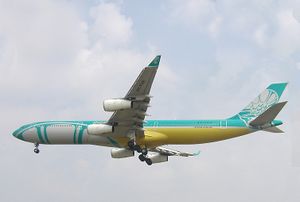PlaneSpottingWorld welcomes all new members! Please gives your ideas at the Terminal.
Airbus A340
| Airbus A340 | |
|---|---|
| Lufthansa A340-600 | |
| Type | Airliner |
| Manufacturer | Airbus S.A.S. |
| Maiden flight | 1991-10-25 |
| Introduced | March 1993 with Lufthansa and Air France |
| Primary users | Lufthansa (43) Iberia Airlines (31) Virgin Atlantic Airways (25) Air France (19) |
| Number built | 338 |
| Unit cost | A340-200 $87,000,000 (1989) A340-300 $171,000,000 (2006) A340-500 $198,000,000 (2006) A340-600 $218,000,000 (2006) |
| Developed from | Airbus A300 |
| Variants | Airbus A330 |
The Airbus A340 is a long-range four-engined widebody commercial passenger airliner manufactured by Airbus S.A.S. a subsidiary of EADS. It is similar in design to the twin-engined A330.
Contents
History
The first published studies for the A340 were as the TA11 in 1981, as shown in the November issue of Air International (coinciding with the display of the A300 at that year's Farnborough Air Show). Concept drawings of the A320 (SA 9) and A330 (TA10) were also published, along with estimated performance figures by Airbus Industrie.
The A340 was launched in June 1987 as a long-range complement to the short-range A320 and the medium-range A300. At the time, Airbus's twinjets were at a disadvantage against aircraft such as the Boeing 747 because of the ETOPS problem: two-engined aircraft had to stay within close range of emergency airfields to allow for engine malfunction. The A340 was designed in parallel with the twin-engined A330: both aircraft share the same wing and similar fuselage structure, and borrow heavily from the advanced avionics developed for the A320. Both the A330 and A340 are assembled on the same final assembly line at Toulouse-Blagnac, France. The four-engined A340 is able to fly long over-water routes. Because of its ETOPS-immunity, Virgin Atlantic Airways used the motto "4 Engines 4 Long Haul," on its A340 fleet.
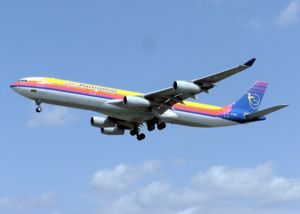
It was originally intended to use the new superfan engines of IAE (International Aero Engines) in the A340 but IAE decided to stop their development and the CFMI CFM56-5C4 was used instead. When the A340 first flew in 1991, engineers noticed a potentially major design flaw in the first model: the wings were not strong enough to carry the outboard engines at cruising speed without warping and fluttering. To alleviate this, an underwing bulge called the plastron, named after the undershell of a tortoise, was developed to correct airflow problems around the engine pylons. The modified A340 began commercial service in 1993 with Lufthansa and Air France.
The A340 incorporates high-technology features such as fully digital fly-by-wire flight control system. It also uses a sidestick controller instead of normal control columns. There is one 'joystick' to the left of the pilot and one to the right of the co-pilot. The A340, as with all Airbus planes, employs a common pilot rating, specially with the two-engined A330. The cockpit also features CRT-based glass cockpit displays on the A340-200 and A340-300 and LCD-based on -500 and -600. Some composite primary structures are also used.
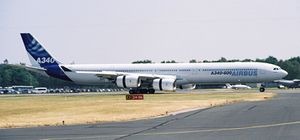
When fuel costs rose, airlines began looking at the Boeing 777 as an alternative to the A340. As the years went by, orders for the 777 rose, while orders for the A340 began diminishing. It can be argued that, with modern engines having extremely low failure rates (as seen in the ETOPS certification of most twinjets) and increased power output, four engines are no longer necessary except for very large aircraft, such as the Airbus A380 or Boeing 747. In 2005, Airbus had only 15 orders for the A340.
In January 2006, Airbus announced plans to develop an enhanced version of the A340, dubbed the A340E; where E stands for enhanced, because of disappointing sales in the wake of newer longer range Boeing 777s in 2005, and the rise in fuel costs that have justified twin-engine planes as being more economical to operate than four engine planes. Airbus claims that the enhanced A340 will be more fuel-efficient than earlier A340s and will allow the model to compete more effectively with the Boeing 777. When this possible model will be developed has yet to be determined.
Variants
There are four variants of the A340 and launched on two separate occasions. The A340-200 and A340-300 were launched in 1987 with introduction into service in March 1993. The A340-500 and A340-600 were launched in 1997 with introduction into service in 2002.
A340-200
One of two initial versions of the A340, the A340-200, with 261 passengers in a three-class cabin layout has a range of 7,450 nautical miles (13,800 km). This is the shortest version of the type and the only version with wingspan measuring greater than the length of the plane. It is powered by four CFMI CFM56-5C engines. The plane's range was one of the longest of the time and it was intended to open long and thin routes, especially over water.
One version of this type was ordered by the Sultan of Brunei requesting for a non-stop range of 8,000 nautical miles. This A340-8000 had an increase in fuel capacity, a MTOW of 275 tonnes similar to the A340-300, and minor reinforcements to the undercarriage. Upon completion its final range was specified at 8,100 nautical miles (15,000 km) . It is powered by the 34,000 lbf (151 kN) thrust CFMI CFM56-5C4s similar to the -300E.
Other A340-200s were later given performance improvement packages (PIPs) which helped them achieve similar gains in capability as to the A340-8000. Those aircraft are labeled A340-213X. The range for this version is 8,000 nm (14,800 km).
Due to its large wingspan, four engines, low capacity, and improvements to the A340-300, the 200 proved heavy and unpopular with mainstream airlines. Only 28 A340-200s were produced with several now in VIP service. South African Airways is the largest operator with 6 flying mostly on Cape Town routes. This version is out of production.
A340-300
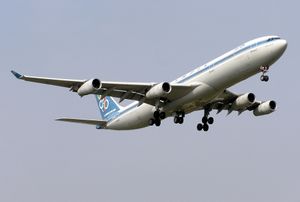
The A340-300 flies 295 passengers in a typical three-class cabin layout over 6,700 nautical miles (12,400 km). This is the initial version, having flown on 25 October 1991, and entered service with Lufthansa and Air France in March 1993. It is powered by four CFMI CFM56-5C engines, similar to the -200.
The A340-313X is a heavyweight version of the A340, and was first delivered to Singapore Airlines in April 1996, though Singapore Airlines no longer operates this model.
The A340-313E is the latest version of this type and was first delivered to Swiss International in 2003. It has a MTOW of 276.5 tonnes with typical range with 295 passengers of between 7,200 and 7,400 nautical miles (13,300 km and 13,700 km). It is powered by the more powerful 34,000 lbf (151 kN) thrust CFMI CFM56-5C4s.
This model is still in production with 219 orders to date of which 211 have been delivered. The largest operator of this type is Lufthansa with 30.
The direct Boeing equivalent is the 777-200ER.
A340-500
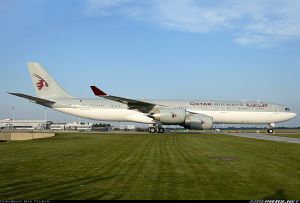
The A340-500 was introduced as the world's longest-range commercial airliner. It made its first flight on 11 February 2002, and was certified on 3 December 2002 with early deliveries to Emirates. While the KC-10 Extender is the longest-ranged production aircraft, the A340-500 was the world's longest-range commercial airliner, until the introduction of the Boeing 777-200LR "Worldliner" in early 2006. The A340-500 can fly 313 passengers in a three-class cabin layout over 8,650 nautical miles (16,000 km). Singapore Airlines, for example, uses this model for its Newark-Singapore nonstop route, an 18-hour, 15,345 km (8,285 nm) journey that is the longest non-stop scheduled commercial flight in the world[1]; the airline does this with a 181 passengers, 2 class layout, and trading payload capacity for extra fuel tanks. The A340-500 is capable of travelling non-stop from London to Perth, Australia, though a return flight requires a fuel stop due to headwinds[2]. Also, Thai Airways International flies this model for its non-stop flights from Bangkok to Los Angeles and Bangkok to New York, while Air Canada flies this model for its non-stop flights from Toronto to Hong Kong.
Compared with the A340-300, the -500 features a 3.3 m fuselage stretch, an enlarged wing area, massive increase in fuel capacity (around 50% over -300), slightly higher cruising speed, larger horizontal stabilizer and smaller vertical tailplane. The A340-500/-600 has taxi cameras to help the pilots during ground maneuvers. The A340-500 is powered by four 53,000 lbf (236 kN) thrust Rolls-Royce Trent 553 turbofans.
The A340-500HGW (High Gross Weight) version with a range of 9,000 nm (16,700 km) and an MTOW of 380 tonnes is due to enter service in 2007 with Thai Airways International. It will use the strengthened structure and enlarged fuel capacity of the A340-600HGW. Kingfisher Airlines plan to use this model to operate the first nonstop flights from India to the United States.[3] The A340-500HGW is powered by four 56,000 lbf (249 kN) thrust Rolls-Royce Trent 556 turbofans.
The direct Boeing equivalent is the 777-200LR, which entered service in February 2006.
A340-600
Designed as an early-generation Boeing 747 replacement, the A340-600 flies 380 passengers in a three-class cabin layout (419 in 2 class) over 7,500 nautical miles (13,900 km). It provides similar passenger capacity to a 747 but with twice the cargo volume, and at lower trip and seat costs. First flight of the A340-600 was made on 23 April 2001. Virgin Atlantic began commercial services in August 2002.
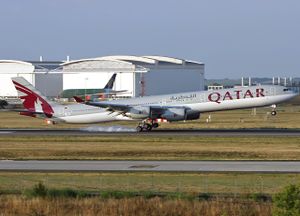
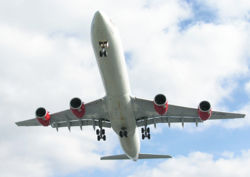
The A340-600 is more than 10 m longer than a basic -300, making it the longest airliner in the world, more than four metres longer than Boeing's 747-400 (but will be 1.1 meter shorter than the upcoming 747-8). It is powered by four 56,000 lbf (249 kN) thrust Rolls-Royce Trent 556 turbofans. It also has an additional four-wheel undercarriage on the fuselage center-line to cope with the increased MTOW.
The initial seven A340-600 aircraft were delivered with overweight wings. After the A340-600 launch customer, Virgin Atlantic, elected to receive replacement aircraft, these airframes were delivered at a reduced price to Iberia Airlines and Cathay Pacific. Cathay Pacific uses the plane on its nonstop service between Hong Kong and New York City (JFK).
The A340-600HGW (High Gross Weight) version first flew on 18 November 2005[4] and was certified on 14 April, 2006.[5] It has an MTOW of 380 tonnes and a range of up to 7,900 nm (14,600 km), made possible by strengthened structure, increased fuel, more powerful engines and new manufacturing techniques like laser beam welding. The A340-600HGW is powered by four 60,000 lbf (267 kN) thrust Rolls-Royce Trent 560 turbofans.
Emirates became the launch customer for the -600HGW when it ordered 18 at the 2003 Paris Air Show[6]; but postponed their order indefinitely in order to wait for Airbus' future plans for the A340 range to be made clear. This order was ultimately cancelled. Rival Qatar Airways, which placed its order at the same airshow, took delivery of the first aircraft on 11 September 2006.[7]
The direct Boeing equivalent is the 777-300ER.
Specifications
| A340-200 | A340-300 | A340-500 | A340-600 | |
|---|---|---|---|---|
| Wingspan | 60.30 m 197 ft 1 in |
60.31 m 197 ft 10 in |
63.45 m 208 ft 2 in | |
| Wing sweep | 30° | 31.1° | ||
| Length | 59.39 m 194 ft 10 in |
63.60 m 208 ft 10 in |
67.90 m 222 ft 8 in |
75.30 m 246 ft 11 in |
| Height | 16.70 m 54 ft 9 in |
16.85 m 55 ft 3 in |
17.10 m 56 ft 1 in |
17.30 m 56 ft 9 in |
| Wheelbase | 23.24 m 76 ft 3 in |
25.60 m 84 ft 0 in |
27.59 m 90 ft 6 in |
32.89 m 107 ft 11 in |
| Typical cruise speed | Mach 0.82 (875 km/h, 544 mph) | Mach 0.83 (885 km/h, 550 mph) | ||
| Maximum cruise speed | Mach 0.86 (917 km/h, 570 mph) | Mach 0.86 (917 km/h, 570 mph) | ||
| Operating range | 14,800 km 9,196 mi |
13,700 km 8,513 mi |
16,700 km 10,377 mi |
14,600 km 9,072 mi |
| Empty Weight | 129,000 kg 284,396 lb |
129,275 kg 295,503 lb |
170,400 kg 375,668 lb |
177,000 kg 390,218 lb |
| Service Ceiling | 11,887 m 38,999 ft | |||
| Fuel Capacity | 155,040 L 40,957 Gal |
140,640 L 37,153 Gal |
222,000 L 58,646 Gal |
204,500 L 54,023 Gal |
| Engine Options | 4x CFM56-5C2 (138.78kN) 4x CFM56-5C3 (144.57kN) 4x CFM56-5C4 (151.25kN) |
4x CFM56-5C2 (138.78kN) 4x CFM56-5C3 (144.57kN) 4x CFM56-5C4 (151.25kN) 4x CFM56-5C4P (149.9kN) |
4x Trent 553 (236kN) | 4x Trent 556 (249kN) |
| Passengers (3 classes) | 239 | 295 | 313 | 380 |
| Cockpit Crew | 2 | 2 | 2 | 2 |
| Takeoff run at MTOW | 2,990 meters | 3,000 meters | 3,050 meters | 3,100 meters |
| ULD Capacity | 18 LD3s/6 pallets | 32 LD3s/11 pallets | 30 LD3s/10 pallets | 42 LD3s/14 pallets |
Sources: [8] [9] [10] [11] [12]
A340 deliveries
By the end of January 2007 a total of 400 A340s had been ordered and 338 delivered.
| 2007 | 2006 | 2005 | 2004 | 2003 | 2002 | 2001 | 2000 | 1999 | 1998 | 1997 | 1996 | 1995 | 1994 | 1993 | 1992 | 1991 |
| 2 | 24 | 24 | 28 | 33 | 16 | 22 | 19 | 20 | 24 | 33 | 28 | 19 | 25 | 22 | 0 | 0 |
Incidents
As at 11 December 2005:
Hull loss accidents The A340 has not had a fatal incident to date, but it has suffered two hull-loss accidents:
- Air France A340-211 (F-GNIA): On January 20 1994, an Air France A340-211 (F-GNIA) was lost to fire during servicing at CDG.
- Air France Flight 358: On 2 August 2005, all 297 passengers and 12 crew survived a crash and fire after their A340-300 (F-GLZQ) overshot runway 24L at Toronto Pearson International Airport in a thunderstorm. The aircraft slid into Etobicoke Creek and broke up. Forty-three were injured, some seriously because some of the emergency slides did not operate properly. This forced some passengers to jump nearly 20 ft (6 m) to the ground.
Other incidents
- An A340-311 of Virgin Atlantic Airways was forced to land with the right main gear retracted on 5 November 1997 at London Heathrow Airport. When landing, the left main gear collapsed. All 100 passengers were unharmed and the aircraft was repaired within 28 days.
- The landing gear of an A340-211 of Sabena collapsed during landing at Brussels Airport on 29 August 1998. The right horizontal stabilizer was destroyed.
- An A340-312 of SriLankan Airlines was destroyed on the ground by Tamil Tiger guerillas on 24 July 2001 at Colombo-Bandaranayake IAP, Sri Lanka, along with 2 A330s and a squadron of military aircraft.
- An A340-313X of Emirates ran off the runway when taking off from Johannesburg International Airport on 9 April 2004. Both pilots were unfamiliar with this heavier variant of the Airbus. At the call to rotate, the pilot flying pulled back on the stick. However, according to a report by the airline, "for approximately six or seven seconds the aircraft nose did not move upward"[13]. The nose finally came up, but the aircraft still did not become airborne. The crew felt a rumbling, selected full power, and about two seconds later the aircraft lifted off the ground[14]. The airport says 25 runway threshold and approach lights, and part of the runway surface, were damaged as the aircraft went over the end of 21R. The pilot had received ambiguous instructions regarding rotation technique during his transition training. Emirates Training establishment was censured by Airbus after an investigation.
- An A340-600 of China Eastern Airlines burst all main landing gears during landing at Shanghai Pudong International Airport. None of the passengers suffered any injuries.
Trivia
- The A340-200 and A340-500 were the longest-ranged airliners in the world when they were first released.
- The A340-600 is the longest passenger airliner in the world at 75.30 m (246 ft, 11 in). It will be surpassed by the 76.4-m long Boeing 747-8 Intercontinental once it enters service.
- The longest regular schedule non-stop flight, Singapore Flight 21 from Newark, New Jersey, USA to Singapore, uses an Airbus A340-500 aircraft. The flight is scheduled for 18 hours, 40 minutes.
External links
- Details on the Airbus family of aircraft
- History and pictures of the Airbus A340-300
- Aircraft-Info.net - Airbus A340-200
- Airbus A340 Production List
- How to build an Airbus A340-600 in about 340 seconds at Google Video
References
- ↑ "Singapore Air makes longest flight", CNN.
- ↑ "Record Longest Flight Flies in the Face of Its Critics", Guardian, 2004-06-29. Retrieved on 2006-08-06.
- ↑ Kingfisher Purchases Five Airbus A340-500 flykingfisher.com
- ↑ New A340-600 takes to the skies (2005-11-18). Retrieved on 2006-08-06.
- ↑ Newly certified A340-600 brings 18% higher productivity (2006-04-14). Retrieved on 2006-08-06.
- ↑ Emirates orders 41 additional Airbus aircraft (2003-06-16). Retrieved on 2006-08-06.
- ↑ Qatar Airways First Airbus A340-600 Arrives In Doha. www.qatarairways.com
- ↑ Airbus - A340-200 Specifications. Retrieved on 2006-08-08.
- ↑ Airbus - A340-300 Specifications. Retrieved on 2006-08-08.
- ↑ Airbus - A340-500 Specifications. Retrieved on 2006-08-08.
- ↑ Airbus - A340-600 Specifications. Retrieved on 2006-08-08.
- ↑ General airliners specfications website. Retrieved on 2006-11-18.
- ↑ A340 Incidents.
- ↑ Emirates A340 Overrun at Johannesburg Still Unexplained (2005-01-31). Retrieved on 2006-08-06.
Related content
Related development
Comparable aircraft
Related lists
See also
Airbus aircraft | ||
|---|---|---|
| Civil | A300 · A300 Beluga · A310 · A320 family (A318, A319, A320, A321) · A330 · A340 · A350 · A380 |  |
| Military | A310 MRTT · A330 MRTT · A400M | |
| In development/ proposed | A350 · A400M · NSR · KC-45 | |
| Other supported types | Sud Aviation Caravelle · Aérospatiale-BAC Concorde | |
| See also | A380 production list · Airbus A380 videos | |
Lists relating to aviation | |
|---|---|
| General | Timeline of aviation · Aircraft · Aircraft manufacturers · Aircraft engines · Aircraft engine manufacturers · Airports · Airlines |
| Military | Air forces · Aircraft weapons · Missiles · Unmanned aerial vehicles (UAVs) · Experimental aircraft |
| Notable incidents and accidents | Military aviation · Airliners · General aviation · Famous aviation-related deaths |
| Records | Flight airspeed record · Flight distance record · Flight altitude record · Flight endurance record · Most produced aircraft |
cs:Airbus A340 da:Airbus A340 de:Airbus A340 et:Airbus A330/340 es:Airbus A340 fr:Airbus A340 gl:Airbus A340 id:Airbus A340 it:Airbus A340 he:איירבוס A340 hu:Airbus A340 ms:Airbus A340 nl:Airbus A340 ja:エアバスA340 no:Airbus A340 pl:Airbus A340 pt:Airbus A340 ru:Airbus A340 sr:Ербас А340 fi:Airbus A330/340 sv:Airbus A340 ta:எயார்பஸ் எ340 th:แอร์บัส เอ 340 zh:空中客车A340
